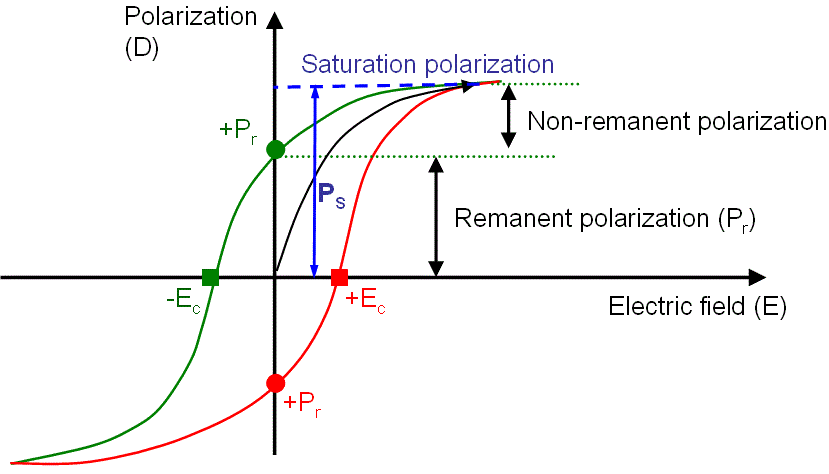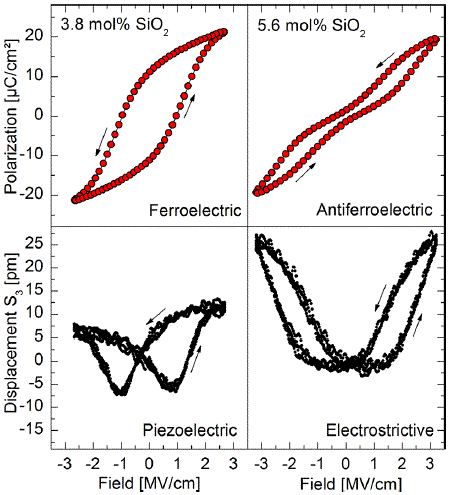=================================================================================
Ferroelectric materials are the electrical analogy of ferromagnets. Joseph Valasek discovered the phenomenon of ferroelectricity in 1921 in University of Minnesota when he was studying the dielectric properties of Rochelle salt (NaKC4H4O6·4H2O) single crystals and observed an electric field hysteresis effect as well as very high dielectric constants (~ 4000) within a certain temperature range. [1] The material is called ferroelectric if a spontaneous polarization can be reversed when an electric field is applied. In other words, in ferroelectric materials, a built-in spontaneous polarization exists in a certain range of temperatures and isotropic pressures without an external electric field. BaTiO3 was one of the first commercially viable ferroelectric materials [7]. Because of this, it has also been one of the most comprehensively studied ferroelectrics with a simple and well-known structure. [8]
Figure 3544a shows a typical polarization versus electric field loop of a ferroelectric material. All the ferroelectric materials today are based on corner-linked oxygen octahedral structures. The simplest configuration is the well-known perovskite structure.

Figure 3544b shows the polarization and piezoelectric displacement measurements of MIM (metal-insulator-metal) capacitor samples with ferroelectric and antiferroelectric Si-doped HfO2 insulators.

Figure 3544b. Polarization (top row) and piezoelectric displacement (bottom row) measurements of MIM (metal-insulator-metal) capacitor samples with ferroelectric (left column) and antiferroelectric (right column) Si-doped HfO2 insulators. [2]
Ferroelectrics are important materials providing outstanding dielectric, piezoelectric, and ferroelectric properties and are widely used in the field of capacitors, transducers, actuators, filters, sensors, and random access memories. The outstanding piezoelectric behavior of ferroelectric materials can be utilized in both active and passive transducer applications.
Furthermore, the ferroelectric property of a material depends crucially on the atomic structure. Figure 3544c shows the schematic illustration of the different classes of crystal systems and their properties. Even though all ferroelectric materials are pyroelectric, piezoelectric, and non-centrosymmetric, the converse is not true. Ferroelectric substances normally present separate regions called domains that have different spontaneous polarization directions. The number of distinct spontaneous polarization directions depends on its point group symmetry.
|
|
|
|
|
|
|
|
|
|
|
|
|
|
|
|
Non-pyroelectric |
|
|
|
|
Non-ferroelectric |
Figure 3544c. Schematic illustration of the different classes of crystal systems and their properties.
The comparison between the pyroelectrics and ferroelectrics is:
i) Below the Curie temperature, both the pyroelectric and ferroelectric substances develop spontaneous polarizations.
ii) If the temperature is raised back above the Curie temperature, the polarization disappears again for both pyroelectric and ferroelectric substances.
iii) When a reversed electric field is applied, the spontaneous polarization reverses in the ferroelectric substances, but not in the pyroelectric substances.
iv) All ferroelectric materials are piezoelectric (but the reverse is not true).
In fabrication of ferroelectric thin films, the films are generally grown at high temperatures above the Curie temperature (TC) holding for the bulk ferroelectrics. The strain relaxation in the films normally takes places during cooling. After the phase transition from the paraelectric to ferroelectric phase occurred, the symmetry is broken and differences in lattice parameters are introduced. That is, after cooling through TC, the symmetry is lowered due to the transition from cubic to tetragonal phases. This symmetry lowering can lead to a preferential formation of domains that is able to relieve the accumulated stress in the film.
Table 3544. Characteristics of ferroelectric materials.
| Characteristics |
|
| Table of characteristics of some specific ferroelectric materials |
page1805 |
[1] J. Valasek, Physical Review, 17, 475 (1921).
[2] TS Böscke, J Müller, D Bräuhaus, U Schröder, U Böttger, Ferroelectricity in hafnium oxide thin films, Applied Physics Letters, 99, 102903-102903-3, 2011.
[3] Hungría M., Amorín H., Algueró M., Castro A., 2011, Nanostructured ceramics of BiScO3–PbTiO3 with tailored grain size by spark plasma sintering, Scripta Mater., 64(1), 97-100.
[4]
Li X., Zhu J., Wang M., Luo Y., Shi W., Li L., Zhu J., Xiao D., 2010, BiScO3-modified (K0.475Na0.475Li0.05)(Nb0.95Sb0.05)O3 lead-free piezoelectric ceramics, J. Alloys and Compounds, 499(1), L1-L4.
[5] Chuprunov E.V., Khokhlov A.V., Faddeev M.A.. The Basics of Crystallography. Editorial board for physical and mathematical sciences. Moscow. 2004. 500p. (in Russian).
[6] Tatyana Karpova, Victor Vassil’ev, Elena Vladimirova, Vladimir Shur,Vera Shikhova,
Vladimir Osotov, Alexander Nosov, Low Temperature Synthesis of the xBiScO3-(1-х)BaTiO3,
x=0÷0.03 Ferroelectric System, American Journal of Materials Science: 2011; 1(2): 133-138.
[7] B. Jaffe, Piezoelectric ceramics, (Academic Press, London, 1971).
[8] G. H. Haertling, Journal of the American Ceramic Society, 82, 4 (1999).
|

